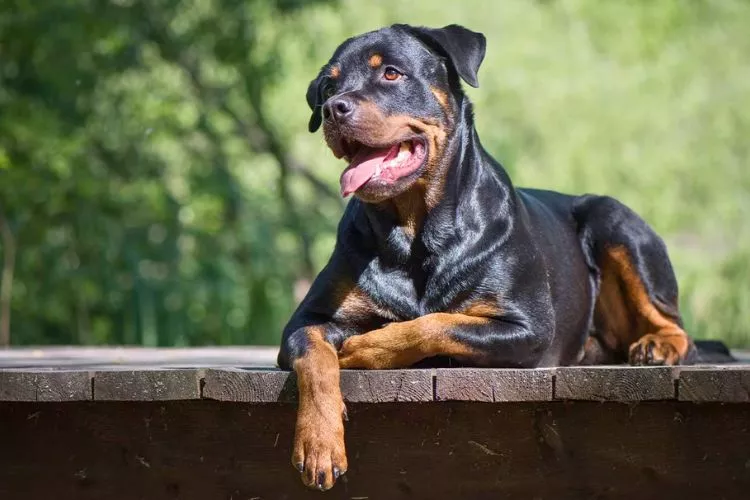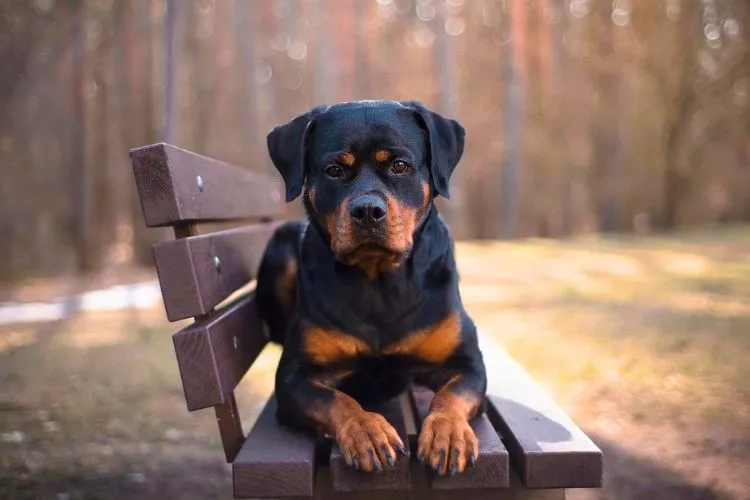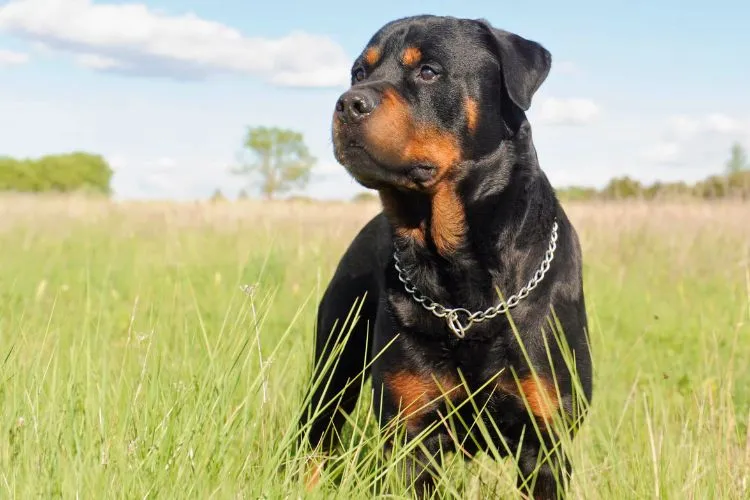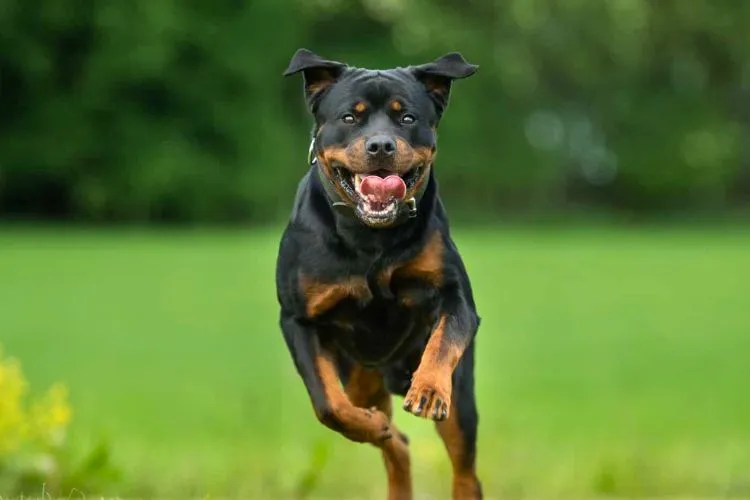Discover the intriguing world of Rottweiler communication as we dive into the fascinating behaviors of these loyal canines. Do rottweilers growl when they’re happy?
Learn how to accurately decode their various vocal cues. Unveil the mystery behind your Rottweiler’s growling and learn to decipher their emotions with ease.

🐾 Do rottweilers growl when they’re happy?
Rottweilers, like many other dog breeds, can sometimes indeed growl when they are happy. This phenomenon is usually referred to as “play growling,” and it occurs when dogs are in a jovial, playful state.
It’s a part of their diverse communication tactics and is generally accompanied by positive body language, such as wagging tails, relaxed posture, and playful bounding.
However, it’s important to understand each individual dog’s body language, as a growl can also signal fear, aggression, or discomfort in some scenarios. As dog owners, knowing to identify the difference is crucial.
🐾 Why do Rottweilers growl so much?
Rottweilers are generally vocal dogs that have a broader range of growls compared to other breeds, and there are several reasons why they tend to growl a lot:

- Communication: As with humans, dogs also have their own language, and growling is a significant part of it. Rottweilers use growls to express various emotions – happiness, playfulness, as well as negative feelings, like irritability or annoyance.
- Instinct: Growling is an instinctive behavior and a defense mechanism. If a Rottweiler feels threatened or uncomfortable, it might resort to growling—a signal to the perceived threat to back off.
- Playfulness: Rottweilers may also growl during play. This activity-associated growl, typically accompanied by relaxed body language, is a harmless way of expressing their excitement.
- Pain or Discomfort: If a Rottweiler isn’t feeling well or is in pain, it might express its discomfort through growls. If the growling is out of character, owners should consider seeking veterinary advice.
- Breeding/Training: Rottweilers are intelligent, protective dogs bred for work that often required assertiveness and alertness, traits communicated via growls. Plus, inadequate or improper training may also lead to excessive growling.
- Seek Attention: Sometimes, Rottweilers might growl to seek their owner’s attention.
Remember, understanding a Rottweiler’s growls means paying attention to their body language and context. It’s always crucial to remember that if a Rottweiler growls at times it normally wouldn’t, it might be a sign of an underlying issue that needs professional attention.
🐾 How do I know if my Rottweiler is happy?
Recognizing when a Rottweiler is happy involves understanding its body language, behavior, and even vocalizations. Here are some indicators that your Rottweiler is in a joyous and content state:

- Relaxed Body Language: A happy Rottweiler will have relaxed, loose body muscles. They stand without any stiffness and have a relaxed tail position.
- Playful Behavior: A content Rottweiler will be energetic and eager to play. They will often invite you to play with a wagging tail, bounding around playfully, or presenting you with a favorite toy.
- Healthy Appetite: Good eating habits are a great indicator of a happy dog. If your Rottweiler is eating regularly, it suggests that they are content and comfortable.
- Being Affectionate: If your Rottweiler seeks your company, shows affection towards you, and enjoys petting sessions, this indicates that they’re happy.
- Interested In Their Surroundings: A curious and interested dog is often a happy dog. If your Rottweiler shows interest in its surroundings, exploring, and sniffing around, they’re likely content.
- Positive Vocalizations: Happy growls, playful barks, or content sighs are vocal signs of a cheerful Rottweiler.
- Healthy Sleeping Patterns: If your Rottweiler is sleeping comfortably through the night and taking relaxed naps in the day, they’re likely happy. In contrast, restlessness, whining at night, or excessive sleeping may indicate stress or illness.
- Bright Eyes and Healthy Coat: Bright eyes and a shiny, healthy coat are physical features suggesting the contentment of your dog.
Remember, everyone’s pet is individual, and these are general indications. Consistency in behavior is generally more important than isolated incidents. If there’s a sudden change in behavior, consult a veterinarian.
🐾 Why do Rottweilers growl and show teeth?
Rottweilers, like other dogs, may growl and show teeth as a form of communication. Here are the common reasons for such behavior in Rottweilers:

- Aggression: Aggression could be a significant reason for a Rottweiler to growl and show teeth. This is often a warning sign to keep distance and is exhibited when the dog perceives a threat.
- Fear: If a Rottweiler feels scared, it may growl and bare its teeth in a defensive posture. This is an attempt to warn away possible threats.
- Resource Guarding: Rottweilers may show teeth and growl due to resource guarding. Dogs may guard their food, toys, sleeping spot, or even a human companion from others approaching.
- Discomfort/Pain: If a Rottweiler is sick or injured and someone touches the painful area, it might growl and bare teeth due to discomfort or to avoid more pain.
- Dominance: In some cases, Rottweilers might growl and show teeth to establish their dominance or to signal that they’re the pack leader.
Identifying the cause involves observing the context in which these behaviors happen. It’s imperative to address any growling or teeth showing promptly and correctly. If it’s frequently related to aggression or fear, guidance from professional trainers or behaviorists may be necessary to prevent escalation.
If you are interested in Labradors: Do labradors bark a lot? | Are labradors hyper?
🐾 frequently asked questions (FAQs)
Answer: If your Rottweiler growls when you pick him up, it could be because he is uncomfortable, anxious, or in pain. Dogs may not understand the intent behind being lifted, and even if they trust you, they may still feel uneasy. Additionally, being picked up might hurt if your dog has an undisclosed injury or ailment. Always approach your Rottweiler calmly and gently to make them more secure and be attentive to their body language to prevent discomfort and stress.
Answer: Your Rottweiler may growl when you hug him as a reaction to feeling restrained, frightened, or trying to establish personal space. Dogs, including Rottweilers, don’t naturally understand the human concept of hugging, and some may perceive it as a threat or feel trapped during a hug. It’s important to be considerate of your dog’s feelings and understand that not all dogs appreciate hugs, even from their trusted owners. Observe their reactions during interactions and respect their level of comfort.
Answer: Rottweilers might growl when you pet them due to discomfort, fear, pain, overstimulation, or an intrusive approach. Sometimes, the petting could accidentally irritate a sore spot leading to discomfort. In other cases, the dog may be fearful or stressed, making them reactive to touch. Paying attention to your Rottweiler’s body language, approaching slowly, and being gentle during petting can help reduce the chances of growling. If the growling persists, consider consulting a vet to rule out any medical issues or seek the advice of a behaviorist.
Answer: Some Rottweilers may growl or show teeth when they’re happy, particularly during playtime. This is known as “play growling” and is different from the growls that express aggression or fear. When they display this behavior, Rottweilers usually exhibit relaxed body language such as wagging tails, soft eyes, and playful movements. It’s important to learn your dog’s individual signals and make certain to distinguish between play growling and other types of growls to avoid misinterpretation.
Conclusion:
In conclusion, yes, Rottweilers can indeed growl when they are happy, demonstrating a behavior often referred to as ‘play growling‘.
However, it’s crucial to interpret this in conjunction with other positive body language signs such as wagging tails, relaxed posture, and playful bounding. Observing these nuances helps understand your Rottweiler better, building a stronger bond based on trust and communication.
Remember, each Rottweiler, like every dog, is unique, and their vocabulary of growls differs. To avoid misunderstanding, always balance your interpretation of any growl within its context.
